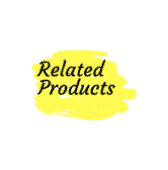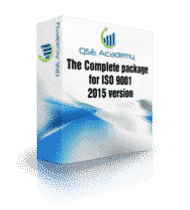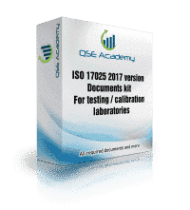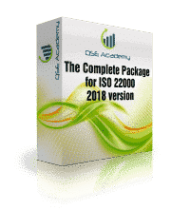QHSE Checklist PDF
2024-10-28 9:24QHSE Checklist PDF




QHSE Checklist PDF
4.8/5
Precise Coverage: Meets all standard requirements.
Instant Download: Get it immediately in Word or Excel.
Easy to Use: Simplifies the audit process.
Limited-time offer: 50 % OFF
Price : 29 $
instead of 58 $
Optimize your QHSE (Quality, Health, Safety, and Environment) management practices with our detailed checklist. Designed to encompass the critical aspects of quality, health, safety, and environmental standards, this tool is available for immediate download in user-friendly Word and Excel formats. This comprehensive checklist is an essential aid for professionals aiming to enhance compliance and streamline management processes in these crucial areas, ensuring thorough adherence to industry best practices.
- Template accessible in both Excel, Word and PDF
- Can be personalized to fit specific organizational needs.
- Includes a license for use by up to 10 people.
- Payments secured through Stripe.
- Mastercard, Visa, Paypal, Apple pay & Google pay payments accepted.
- Access your template whenever you want.

QHSE Checklist
If you’re planning to prepare a Quality, Health, Safety, and Environment (QHSE) Management System, where should you begin?
We recommend starting with a Gap Analysis to identify the differences between your current management system and the requirements of a comprehensive QHSE Management System. A Gap Analysis helps assess your organization’s scope, readiness, and resources for developing the QHSE Management System. This analysis provides essential data to create a detailed project plan for QHSE implementation.
This gap analysis checklist is a valuable tool for evaluating your QHSE Management System against relevant standards and requirements.
The QHSE checklist is an excellent resource for auditors, aiding in the creation of audit questionnaires to verify the effectiveness of the implemented QHSE Management System. There are numerous internal audit requirements based on best practices and relevant standards.
Organizations applying for or renewing their QHSE certifications should complete this checklist. Additionally, if significant changes have been made to the management system’s structure, the QHSE checklist should be updated.
The sections in the QHSE checklist follow the order of the applicable standards. In some instances, they are also referred to as supplementary required documents.
What is a QHSE Audit Checklist?
A QHSE (Quality, Health, Safety, and Environment) audit checklist is a comprehensive tool designed to assist auditors in evaluating the effectiveness of an organization’s integrated management system covering quality, health, safety, and environmental aspects. This checklist serves as a guideline to ensure all elements of the QHSE system are properly implemented and maintained, covering critical areas such as policy, planning, operational controls, compliance with legislation, and continuous improvement processes.
By systematically addressing each requirement, the checklist helps identify areas where the organization excels or needs improvement, facilitating targeted actions to enhance overall QHSE performance. This structured approach not only supports compliance but also aids in sustaining long-term quality, health, safety, and environmental goals, making it essential for organizations committed to ensuring a safe, healthy, and sustainable workplace.
What Does a QHSE Audit Checklist Include?
A QHSE Audit Checklist thoroughly evaluates an organization’s integrated management system against relevant standards (such as ISO 9001, ISO 14001, and ISO 45001) and legal requirements, ensuring comprehensive compliance and effective management. The checklist covers:
- Scope: Understanding the boundaries of the QHSE system.
- Normative References: Ensuring all referenced standards are considered.
- Terms and Definitions: Clarity on all terms used within the standards.
- Context of the Organization: Evaluating external and internal factors that affect the QHSE system.
- Leadership and Worker Participation: Assessing leadership’s role and commitment and the participation of workers in health and safety.
- Planning: Checking for proper planning of QHSE objectives and processes, including risk assessments and legal compliance.
- Support: Verifying availability of resources, including competence, awareness, communication, and documented information.
- Operation: Examining operational planning and control, including emergency preparedness and response for health, safety, and environmental aspects.
- Performance Evaluation: Monitoring, measurement, analysis, and evaluation of the QHSE system.
- Improvement: Identifying opportunities for improvement and taking corrective actions.
This checklist serves as a vital tool for organizations aiming to enhance QHSE performance and ensure compliance with quality, health, safety, and environmental regulations.
How to Prepare for a QHSE Audit?
Preparing for a QHSE audit involves several key steps to ensure your integrated management system complies with relevant standards and legal requirements:
- Review Documentation: Make sure all your QHSE policies, procedures, and records are up to date and align with relevant standards (e.g., ISO 9001, ISO 14001, ISO 45001) requirements.
- Conduct Internal Audits: Perform regular internal audits to identify gaps and non-compliance issues. Address these issues promptly.
- Employee Training: Train your employees on the QHSE system and their specific roles in maintaining compliance.
- Management Review: Have top management review the QHSE system’s performance, ensuring it meets strategic objectives and continues to improve.
- Corrective Actions: Implement necessary corrective actions to address any discrepancies found during internal audits or previous external audits.
By meticulously preparing and addressing these aspects, you can help ensure a smooth QHSE audit process.






